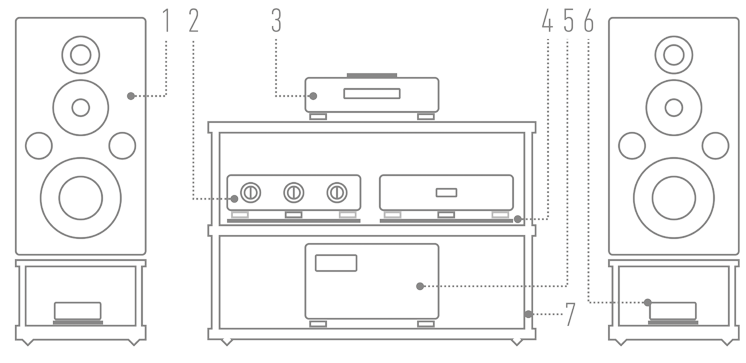|
INTEGRATED AMPLIFIER AUDIO REVEAL
Manufacturer: ALTRONIK |

|
Review
text WOJCIECH PACUŁA |

|
No 258 November 1, 2025 |
|
˻ PREMIERE ˼ ⌈ AUDIO REVEAL is a brand established in 2016 on the initiative of Mr. MICHAŁ POSIEWKA. He has been involved in manufacturing since 1989, but at that time he was designing and manufacturing alarm systems. Audio Reveal is the result of his passion for audio. We are testing for the first time an amplifier that works with 300B tubes, the Classique model. ⌋ MICHAŁ POSIEWKA, founder, owner and designer, is an audiophile. That is to say, he is a human being first and foremost, but an audiophile second. His idée fixe was therefore to design an amplifier for himself that would meet his requirements and not be prohibitively expensive. The problem with the latter was that he wanted it to be a tube amplifier operating in class A, single-ended mode, with a single tube at the end. This meant an expensive power supply and equally expensive, if not more so, output transformers. 
This reflection resulted in the first commercial product presented in 2018. From the very beginning, even though the company had been founded two years earlier, which, as Marek Dyba noted in his review of the Hercules DAC, showed that rushing to prepare products is not in the nature of this manufacturer, Michał chose Audio Reveal as the name for his brand because the devices were intended to reveal to users “new layers of information and emotions recorded in recordings.” The first model with this logo was called → FIRST (test of the Mk II version → HERE ˻PL˺). For signal amplification, small triodes on the input and a KT88 beam tetrode on the output were used, yielding 10 W. The next model, → SECOND, worked with KT150, which resulted in output power of almost 20 W, reaching over 21 W per channel in the → SECOND SIGNATURE version, thanks to KT170 tubes. The amplifiers were great, solidly built, and easily demonstrated what this type of design is capable of. However, sooner or later, every tube amplifier designer wants to deal with the legend: the 300B triode. It is the “queen” of this type of design and even if some people think that the 2A3, 211, or 845 are even better, it is the 300B that is the center of attention and the object of desire for both audiophiles and designers. ▌The Classique SO, IT COMES AS NO SURPRISE that, after nine years, Audio Reveal introduced the SET amplifier, i.e., a single-ended triode one, based on a directly heated 300B triode on the output. All the previous designs were beam tetrodes, i.e., pentode equivalents. But this would not be Audio Reveal's first product of this type, because – let us recall – last year the Hercules digital-to-analog converter was presented and tested by us for the first time, in which these “magical” tubes were used on the output of the analog section.; more → HERE. ▲ A few simple words with… MICHAŁ POSIEWKA 
AUDIO REVEAL, in order to meet customer expectations, has introduced a new amplifier model called the Audio Reveal Classique to its range. This model joins the family of devices based on 300B tubes (alongside the Hercules converter) and, at the same time, the line of integrated single-ended amplifiers. The Classique amplifier is a dual mono design with separate power supply sections and mains transformers for both channels. The preamplifier section features 12AT7 and 12AU7 tubes, while the output stage uses a single 300B triode. The anode voltage of the tubes is additionally filtered by chokes in an LC circuit. The design of the device continues the design line of Audio Reveal devices – a solid heavy casing, a panel made of exotic Merbau wood, steel hand-turned knobs and the highest quality of workmanship are the elements that make these amplifiers unique. Its sound quality is due to its well-thought-out electrical and mechanical design, as well as the use of high-quality components. MP THE CLASSIQUE IS AN INTEGRATED AMPLIFIER. This means that it combines a preamplifier (linear) section and a power amplifier (current) section in a single enclosure. It is quite large, measuring 476 x 410 x 220 mm, and weighs solid 33.5 kg. It is best if two people carry it. 
At the front, there is a large volume knob and two smaller ones for changing inputs and switching AC power on and off. There is also an LED that changes color from red in start-up mode to orange. The start-up sequence lasts 60 seconds and is designed to protect the tubes from excessive initial current, which extends their life. Protective cages can be placed over the tubes, as required by the European Union, but this would be a sacrilege – after all, 300B tubes look phenomenal. Twin low-power 12AT7 (ECC81) and 12AU7 (ECC82) triodes operate in the input section of the device, while a single 300B triode serves as the output tube. All of the tubes in the tested device come from the Chinese brand Psvane Audio Lab, owned by Changsha Hengyang Electronics Co., Ltd. The 300B tube (UK Series 300BL) bears the UK Design logo. This is a sub-brand of Psvane, offering replicas of its versions once manufactured in the United Kingdom. In this case, its anodes are gray, as in NOS tubes, and its pins are gold-plated. According to the manufacturer, these measures were taken to achieve “high detail in sound reproduction.” It also adds that “the sound quality is no less than that of some well-known British vintage tubes.” The device has low power, 8 W per channel, at 1 kHz and 5% THD distortion. Its frequency response does not seem impressive either, as it ranges from 20 Hz to 30 kHz (+0, -3 dB), but in tube amplifiers this works differently than in transistor amplifiers. There are technical explanations for this phenomenon, but I will just say that you can simply hear it. In fact, people even talk about “tube watts.”. In his article How Many Watts Do You Really Need? Mac McDonough writes:
The amplifier offers four RCA line inputs and two speaker outputs, with 4 and 8 Ω taps. The sockets are gold-plated, screw-on and look solid. They probably come from a Chinese factory. The set includes a metal Audio Reveal RM-1 remote control with two buttons – volume up/down. It is worth buying two O-rings from a hardware store and sliding them on. This will prevent it from slipping. The device looks similar to other products from this company: it has a wooden front and a metal steel casing. It uses a classic contemporary layout, i.e. the control tubes are at the front, followed by the output tube, and the transformer boxes at the rear. The tested device also has two smaller boxes with chokes between the tubes. The casings and housings of the transformers and chokes are powder coated in black, and brass plates with the symbol of the component are affixed to their tops. This was how manufacturers marked them in the 1940s and 1950s, and today it is practiced by companies in Japan. The plate bearing the manufacturer's logo and the name of the amplifier is also made of brass. 
The manufacturer emphasizes the high quality of the components used – and indeed it is so. In the signal path, we see ClarityCap capacitors from the ESA series, i.e., low tolerance and metallized aluminum, high-quality polypropylene ones. There are also other polypropylene capacitors from Wima, and the resistors are almost exclusively precision components from Dale. The power supply uses Nichicon capacitors, and volume is controlled by a rotary attenuator (potentiometer) from Alps. The device has a dual-mono design, including the power supply. Although all other devices from this company look similar, the Classique model features certain elegance reminiscent of Audio Tekne amplifiers, which I find beautiful; take a look at the TFM 2000 integrated amplifier → HERE and tell me if I’m wrong... ▌ THE LISTENING SESSION THE WAY WE LISTENED • The Audio Reveal Classique integrated amplifier was tested in the "High Fidelity" reference system. It was compared to the reference amplifier, the Soulution 710 transistor power amplifier with the Ayon Audio Spheris Evo tube preamplifier. During the test, I used the Ayon Audio CD-35 HF Edition SACD player and the Sforzato PCM-05 EX file player with the DSP-05 EX clock as the source. 
Signal between the Ayon player and the amplifier was transmitted via a Crystal Cable Absolute Dream RCA interconnect, and between the file player and the amplifier via Siltech Single Crown interconnects. Signal was delivered to the Harbeth M40.1 speakers via a Crystal Cable Da Vinci speaker cable. The amplifier was powered by a Harmonix X-DC350M2R Improved-Version cable. |
» ALBUMS USED IN THE TEST ⸜ a selection
⸜ DIANA KRALL, Wildflower, Verve Records/Universal Music (Japan) UCCV-9577, SHM-CD + DVD ⸜ 2015. WHAT A GREAT SOUND! Michał Posiewka's amplifier has been tuned to perfectly match the idea of how a 300B tube should sound. And it does it perfectly. The sound is very clear on the one hand, and naturally soft on the other. This device approaches music not in a cool and rational way, but in a way that suggests the warmth radiating from the smile on the designer's face. 
The thing is, the Classique sounds as if it was to be our last amplifier ever. As if we no longer had to look for anything else and could finally focus on music, sending technology into the past with a powerful kick. This is an intentional effect; we are not talking about a perfect amplifier. But when it comes to the problems and choices that manufacturers face when designing devices, even ultra-expensive ones, the Polish amplifier comes out on top. It's warm, dense, rich and gutsy sound. And very dynamic at that. You are probably wondering how it is possible that I am talking about dynamics – and I can add one more word: “bass” – in the context of an eight watt amplifier driving the difficult-to-handle Harbeth M40.1 speakers. Even if you're not, since I brought up the subject, it's important to mention it. The device sounds as if it has watts stored in some kind of a reservoir, which it freely uses to build large, expansive sound with low tonal balance. Yes, it is low, warm, almost dark sound. I add the latter conditionally, because it is not about withdrawing the high midrange and treble. The vocals of DIANA KRALL from the album Wildflower retained slight sibilants, which the producers – including the pianist – did not filter out. It's a delicate touch, but it opens up the sound nicely. But even this detail was interpreted by the Polish amplifier as part of the dynamics. This brings us back to my question and your – imagined – curiosity about whether the amplifier's power in the test is sufficient to drive classic speakers in a medium-sized room. It is sufficient – to put it briefly. The current efficiency of this device is excellent and I did not feel that there were any shortcomings in the sound. Even the four-part Silver Grand Mono II amplifier from another Polish company, Ancient Audio, which costs over PLN 200,000 and was playing in the same place a moment earlier, did not sound (much) more dynamic and louder. It was much better in this respect, but the Classique did it with real panache. The thing, I think, is how gently, how gracefully the Audio Reveal amplifier goes into overdrive. You can't hear it – I couldn't pinpoint the moment when it starts. When you turn up the volume knob and play material that requires pumping air, such as VAN HALEN's debut album, you can throw the device off balance. At some point, you will hear distortion and hoarseness, and it will no longer make sense. But it will be really loud. And even then, it won't be very unpleasant. When listened to within its range, the Polish amplifier sounds delightfully beautiful. Because that's what it's all about, isn't it? It is incredibly clean and transparent to the signal source, because the triangle struck at the beginning of THE OSCAR PETERSON TRIO's album We Get Request, in the song You Look Good To Me, was incredibly sweet, had weight, but also sounded very clear – similarly to the double bass in the right channel or the leader's piano positioned on the listening axis. I mention that the album begins with You Look Good To Me because I am listening to the 2009 version released by Winston Ma's Lasting Impression Music label on the 24 Gold Direct-from-Master Edition UDM album – originally, the album opened with the song Quiet Nights Of Quiet Stars (Corcovado). I mention clarity because this is a recording which, in this version, is one of the most dynamic, clearest, and at the same time harmonically saturated releases. 
The amplifier under review perfectly demonstrated everything I am talking about, while remaining true to its own style of sound reproduction. So, the sound seemed warm and sweet. And I think that's how it really is, especially when compared to the aforementioned Ancient Audio amplifier. In this respect, it is closer to the sound of Kondo Ongaku than – referring to the same brand – Kondo Gakuoh. It is internal warmth, not imposed from outside, which is why it is not invasive. You listen to music in comfort, not tension. Perhaps this is also because vocals are rarely rendered so well. My system does it in an even more resolving way, while the aforementioned Silver Grand Mono II will sound in a clearly more selective manner. However, the Classique has something in its sound that makes ELVIS PRESLEY's voice in ˻ 2 ˺ Fever, a song from the album Elvis is Back! sound so good that it really gives you goosebumps. Once again, we will be surprised by the volume of sound and its bass. It will not be particularly selective, and perhaps this is where we should look for the source of such excellent energy distribution. Selectivity is limited here to larger planes rather than individual sound sources. These have a general outline rather than a clear texture. But the “range” I am talking about is so deep that the richness of the sound is really surprising. The device won’t solve recording problems. If the sound is somewhat dry and dense, as in the case of ˻ 1 ˺ Red Rain, a track from PETER GABRIEL’S So album, it won't suddenly become tidy, but will definitely get slightly sweetened. I also heard Tony Levin's punchy bass, which went really low and, above all, had perfectly preserved attack and decay. There was no hint of bloated sound or slowness. But with this type of repertoire, the tested amplifier will require speakers with higher efficiency if we want to play music at a higher-than-normal volume. If not, there is no problem and even the expansive ˻ 2 ˺ Sledgehammer based on powerful percussion, bass and brass instruments will sound lively and syncopated. Gabriel's vocal was presented clearly and focused, and had a very nice tone. The amplifier gently cut its dryness, though it did not turn it into the warmth known from Nat ”King" Cole's albums. With all these recordings, the Polish amplifier demonstrated something I would call composure, in the sense that it did not react nervously to anything that reached it. It correctly selected the colors, space, scale and perspective for the recordings and albums. That is why, right after Gabriel, I listened with such pleasure to the 2008 remastered album Vienna by ULTRAVOX. The device played with broad sound, using the extremes of the sound stage, with good sound distribution in the panorama and controlled, balanced, warm vocals of Midge Ure – who joined the band shortly before recording this album – and voices of the other band members in the backing vocals. The synthetic pulse of the drums in the title track, ˻ 8 ˺ had both a very good dry (electronic) snare drum beat and full bass. You're really going to like this. Spatially, the amplifier is situated on the side of devices that slightly distance the foreground from us and build deep background behind it. The apparent sources, i.e., instruments and effects, are shown in a distinct and varied manner, but rather in continuity, with a kind of lightness rather than a clear separation of edges. It is a message based on larger planes, not trying to go deep into drawing details and specifics. In other words, it is extremely “tube-like.” ▌ Conclusions The CLASSIQUE by AUDIO REVEAL is one of the most interesting amplifiers with a 300B tube currently available on the market. It is also one of the best Polish amplifiers overall. It has incredible momentum, rich colors, and is internally warm; it is also resolving. It does not dazzle with selectivity; it is not that type of device. Instead of details, it provides information, replacing isolated events with complex structures. It is rich, dense sound with tangible sound sources. 
The amplifier seems to play warmly – and let it stay that way. It shows low, powerful bass with great control. It doesn't go as low as the reference amplifier and doesn't build such all-encompassing space – but for that you need higher power. And yet, this is not heard as a shortcoming. Because the sound we get is absolutely complete, pleasant and simply captivating. And the amp is also kind to poorly made recordings; better ones, such as ˻ 3 ˺ Take Five from THE DAVE BRUBECK QUARTET’s album Time Out, are shown with real virtuosity. We award it the ˻ GOLD FINGERPRINT ˺. ● ▌ Technical specifications (according to the manufacturer)
Driver tubes: 12AT7 (ECC81), 12AU7 (ECC82) 
THIS TEST HAS BEEN DESIGNED ACCORDING TO THE GUIDELINES adopted by the Association of International Audiophile Publications, an international audio press association concerned with ethical and professional standards in our industry, of which HIGH FIDELITY is a founding member. More about the association and its constituent titles → HERE. |

|
Reference system 2025 |
|
 1) Loudspeakers: HARBETH M40.1 |REVIEW| 2) Line preamplifier: AYON AUDIO Spheris III Linestage |REVIEW| 3) Super Audio CD Player: AYON AUDIO CD-35 HF Edition No. 01/50 |REVIEW| 4) Stands (loudspeakers): ACOUSTIC REVIVE (custom) |ABOUT| 5) Power amplifier: SOULUTION 710 6) Loudspeaker filter: SPEC REAL-SOUND PROCESSOR RSP-AZ9EX (prototype) |REVIEW| 7) Hi-Fi rack: Hi-Fi rack: finite elemente MASTER REFERENCE PAGODE EDITION Mk II, more → HERE |
|

|
Cables Analog interconnect SACD Player - Line preamplifier: SILTECH Triple Crown (1 m) |ABOUT|» ANALOG INTERCONNECT Line preamplifier → Power amplifier: Siltech ROYAL SINLGE CROWN RCA; review → HERE Speaker cable: SILTECH Triple Crown (2.5 m) |ABOUT| |

|
AC Power Power cable | Mains Power Distribution Block - SACD Player: SILTECH Triple CrownPower (2 m) |ARTICLE| » POWER CABLE Mains Power Distribution Block → Line preamplifier: Acoustic Revive ABSOLUTE-POWER CORD, review → HERE » POWER CABLE Mains Power Distribution Block → Power amplifier: Acoustic Revive ABSOLUTE-POWER CORD, review → HERE Power cable | Power Receptacle - Mains Power Distribution Block: ACROLINK Mexcel 7N-PC9500 (2 m) |ARTICLE| Power Receptacle: Acoustic Revive RTP-4eu ULTIMATE |REVIEW| » ANTI-VIBRATION PLATFORM under Acoustic Revive RTP-4eu ULTIMATE: Graphite Audio CLASSIC 100 ULTRA, review → HERE Power Supply Conditioner: Acoustic Revive RPC-1 |REVIEW| Power Supply Conditioner: Acoustic Revive RAS-14 Triple-C |REVIEW| Passive filter EMI/RFI: VERICTUM Block |REVIEW| |

|
Anti-vibration Speaker stands: ACOUSTIC REVIVE (custom)Hi-Fi rack: finite elemente MASTER REFERENCE PAGODE EDITION Mk II, more → HERE Anti-vibration platforms: ACOUSTIC REVIVE RAF-48H |ARTICLE| » ANTI-VIBRATIONAL FEET: |

|
Analogue Phono preamplifier: Phono cartridges:
Clamp: PATHE WINGS Titanium PW-Ti 770 | Limited Edition Record mats:
|

|
Headphones » HEADPHONE AMPLIFIER: Leben CS-600X, review → HEREHeadphones: Headphone Cables: Forza AudioWorks NOIR HYBRID HPC |
main page | archive | contact | kts
© 2009 HighFidelity, design by PikselStudio,
projektowanie stron www: Indecity


















